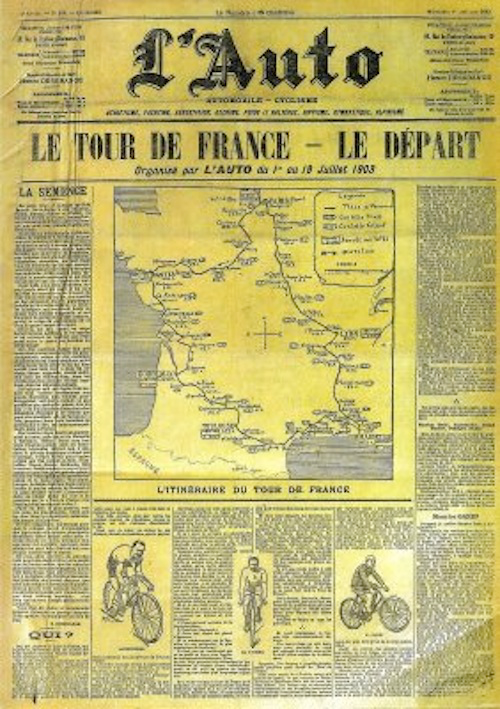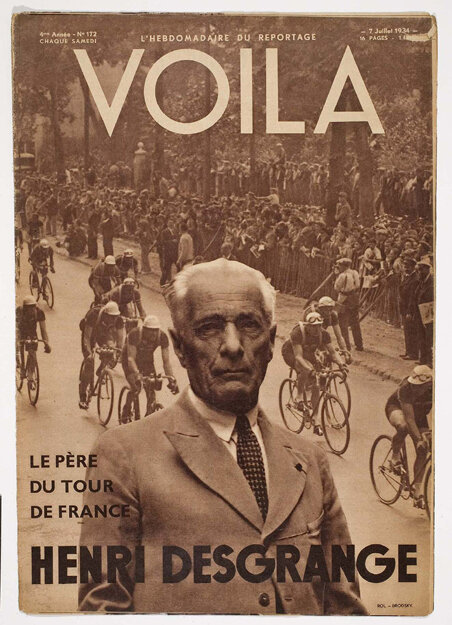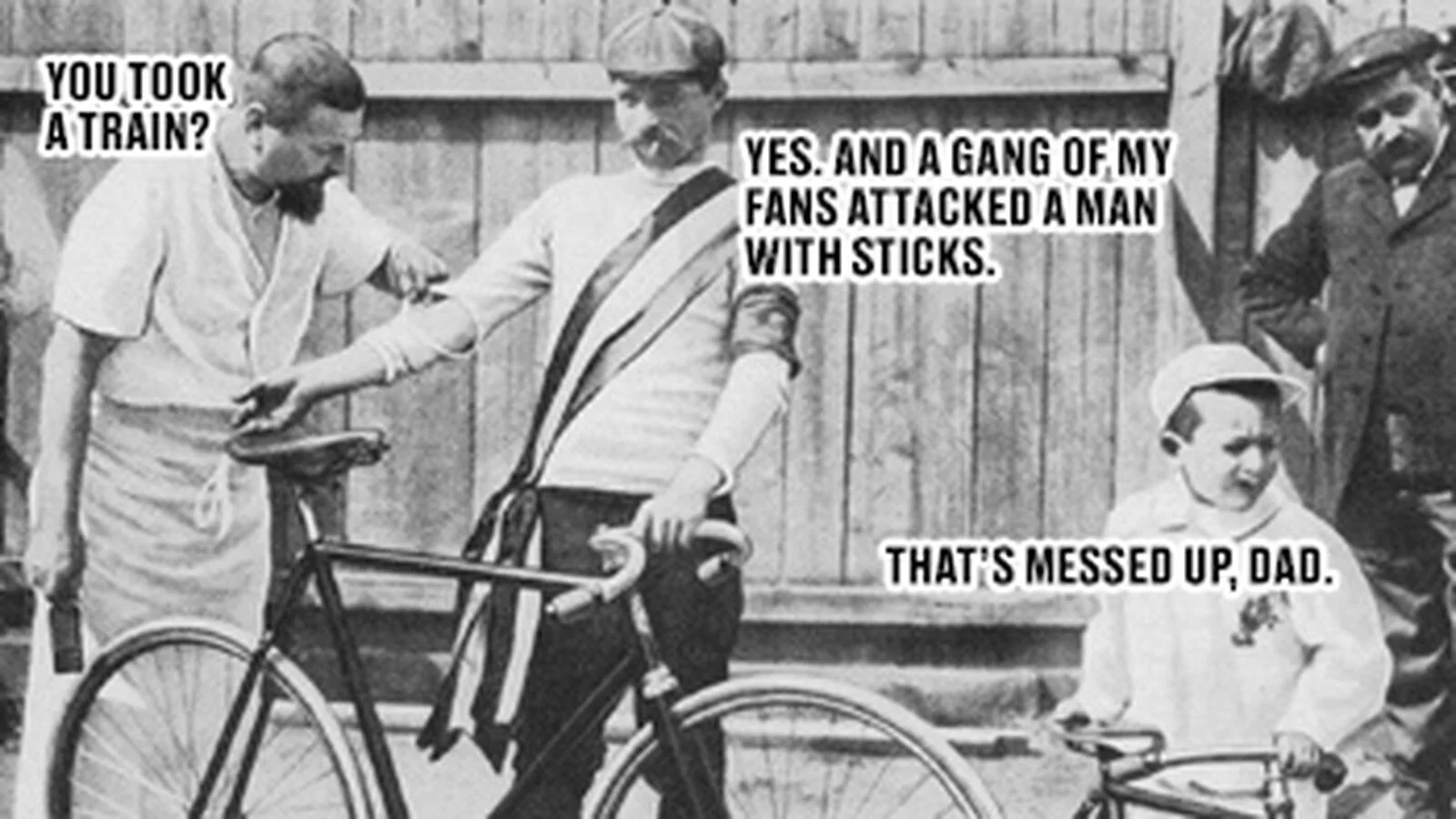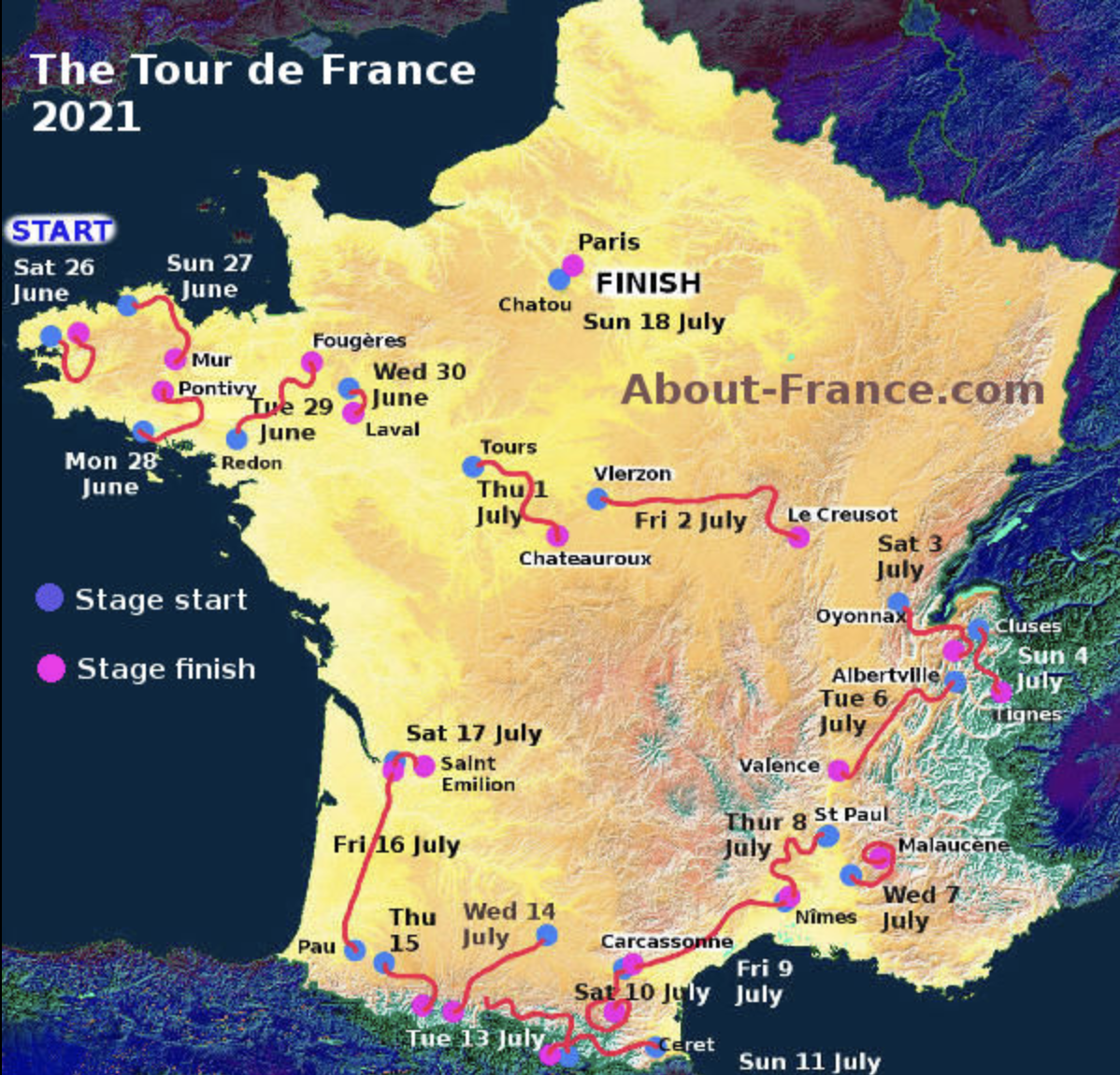Tour de France 2021: Sat, Jun 26, 2021 – Sun, Jul 18, 2021
The first Tour de France was in 1903. It was an exciting event even at its inception. The first tour had 60 cyclists, was 17 days long, 1500 miles, and set up into six stages: from Paris to Lyon, Marseille, Toulouse, Bordeaux and Nantes before returning to the French capital.
That said, the Tour de France began as another sort of “competition” — a competition to see who could sell the most newspapers!
Henri Desgrange was a French cyclist and journalist who had a paper called “L’Auto.” Circulation was about 25,000. His rival was the paper “Le Vélo” printed on green paper with a circulation of 80,000.
L’Auto, printed on yellow paper, (and thus, the Yellow Jersey) quickly went from 25,000-65,000 with a post race special edition circulation of 130,000.
The success of L’Auto was at the detriment of Le Vélo that consequently went out of business in 1904. L’Auto became "L’Equipe” in 1944.
Desgrange won that “competition.”
“The Father of the Tour de France: Henri Desgrange.” Today's yellow jersey features the initials of Henri Desgrange in honor to his championing the race from its inception.
The crowds cheer “Allez! Allez! Allez!”
Riding through a village.
Maurice Gaurin. 1871-1957.
The rules of the Tour are the same: which ever rider has the best times (e.g. the least amount of time to win the stages) is declared the winner of the over all race. The first person to win the overall Tour and wear the Yellow Jersey as the champion in 1903 was Maurice Gaurin.
Gaurin won the first Tour de France using a bike named “La Francais” that had no gears. It was a heavy bike weighing in at almost 40 pounds. Still, Gaurin was able to ride at an average speed of about 16 miles per hour.
Maurice Gaurin, 1903. La Francais.
These days, competitive cycling is advanced in aerodynamic technology as well as in athleticism. Bikes weigh approximately 15 pounds and cannot weigh any less than 6.8 kg (14.99 pounds.) Average speeds (factoring in downhill, uphill, and the flats) are about 25 mph. Speeds can get up to 65 mph on the downhill though!
For comparison purposes, below is a little video vignette made by contemporary cyclists replicating the first stage of the 1903 Tour from Paris to Lyon using 1903 equipment and gear. This shows how difficult those early races were and also how tough the riders had to be to make it through (which not many did.)
Waiting for the cyclists to arrive. 1903.
The Tour de France has always been an intense test of endurance pushing the body to its maximum effort and limits. Each year, the course changes. This year, in 2021, riders will be taking one of the toughest climbs - up Mont Ventoux in the Pyrenees - not once but twice, and likely in the same day. Known as “The Giant of Province,” “The Ventoux is a god of evil, to which sacrifices must be made. It never forgives weakness and extracts an unfair tribute of suffering,” is the famous quote from French philosopher Roland Barthes (1915-1980), who was an avid cycling fan.
Riding up Mont Ventoux.
Cigarettes and wine were a staple of the French culture in the early 1900s and became part of the riding experience. Smoking was believed to open up the lungs and riders would light up before taking on a big climb.
Tour riders in 1903 would consume strong red wine to get through the physical ordeal of the race including perilous night riding.
Gaurin’s diet on the Tour:
19 litres of hot chocolate
seven litres of tea
eight cooked eggs
a mix of coffee and champagne
45 cutlets
five litres of tapioca
two kilos of rice
and oysters.
The 2021 Tour features a rider from Australia, 29-year old Lachlan Morton, who will ride the entire 2,100 mile Tour route, including at night, as an homage to the riders of the first race in 1903.
Morton says his solo unassisted ride will be an attempt to reconnect with the original spirit of the Tour, in which riders raced through the night, slept rough in fields and ditches and ate where and when they could.
“I just think that era of cycling was really exciting,” Morton said. “At that time, the Tour director basically wanted one finisher, so it was a totally different sport compared to what it is now. The scope and scale of the stages then were really inspiring.”
Morton began the ride in Paris on June 26 one hour behind his teammates to avoid the crowded field of cyclists. Because he will be night riding as well as having no rest days between stages, he expects to beat his teammates at the finish in Paris on July 18.
“It’s a celebration of the original Tour and what it was all about to begin with. I realized it was going to be a huge undertaking. I’m not even sure if it’s possible.”
I wonder if Lachlan Morton will consume mass quantities of red wine, too, as the 1903 riders did? Might be a good idea as he will be on his bike approximately 12 hours/day with no rest days between stages.
Not the easiest race to endure, cheating was involved since the beginning of the race because of the intensity of the sport. Officials were quick to disqualify cheaters even in the beginning.
There are stories of outright bullying in the 1903 race by the first winner of Tour, Maurice Gaurin, when Gaurin would get his team mates to push a rival off his bike. Sometimes Gaurin physically destroyed the bikes of his opponents by jumping up and down on them.
Somehow Guarin got away with cheating in 1903. But he didn't in 1904. After accusations and investigations revealing testimony from dozens of competitors and witnesses of illegal use of cars and trains, nine riders were disqualified including Gaurin. Gaurin then retired from cycling, took what earnings he built up, and opened a car garage and filling station in Lens, France. The garage became very popular when word got out to motorists that Gaurin was filling their tanks, happily regaling about his triumphs of the Tours past.
Tour de France 2021. Now a 2,100 mile trek, the entire country of France is turned into a velodrome for this 21-stage, 23-day event.
mail·lot
/mīˈyō/
French word for “shirt.”
Maillot jaune - yellow jersey - Since 1919, the leader of the general classification, the most important classification, wears the yellow jersey. Prior to 1919, the leader wore a green arm band. Yellow was chosen for the organizing newspaper L'Auto which was printed on yellow paper. The initials of Henri Desgrange are located on the Yellow Jersey, usually near the waist.
Tour de France Jerseys
Maillot blanc - White Jersey first appeared in 1968 to reward the leader of the combined classification, which was based on the overall, points and mountains standings, it wasn’t until 1975 that it began to symbolize the future and youth of the Tour de France peloton. A leader in waiting, the wearer of the white jersey, is the best placed in the overall standings who is under the age of 26.
Maillot vert - Green Jersey. created in 1953 on the tour's 50th anniversary - rewards the rider who is leading the points classification each day.
Maillot pois rouge - Polka Dot Jersey: is awarded to the Tour de France’s leader of the best climber classification. Although this classification was introduced in 1933, its symbol, the polka dot jersey, appeared in 1975.
The audience lines the streets.
The Tour de France is a testament to grit and determination, to mental strength and physical endurance.
It is also live theatre portraying human potential in the thrill of victory and in some cases truly sad loss of life of that potential along its strenuous course; and of human pathos of the agony of defeat and disqualification.
Live theatre requires a live audience. The audience cheers away on the ground in France, or virtually across the globe. “Allez! Allez! Allez!”
The audience, like Tour champion Maurice Gaurin of years bygone, regales in the tales of the race as though they were just leaving the theatre, bubbling with excitement.
“All the World’s a Stage.”- William Shakespeare.
“Allez! Allez! Allez!”
Tour de France - Allez! Allez! Allez!!
Maurice Gaurin and “La Francais.”
Mary Lamery is a lifelong resident of Seattle, Washington, USA and native of the Pacific Northwest.
Lamery paints regional landscape and makes drawings in a manner that leans towards 19th century French Impressionism.
Her landscapes and drawings invite the viewer to add to the backstory of the composition through personal identification with the paintings and story telling of the experience.
Follow Mary on Instagram.
















